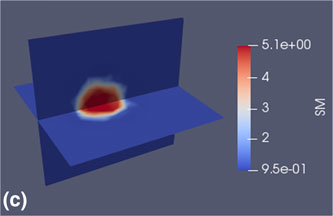Article contents
Characterization of the stiffness distribution in two and three dimensions using boundary deformations: a preliminary study
Published online by Cambridge University Press: 07 June 2018
Abstract

We present for the first time the feasibility to recover the stiffness (here shear modulus) distribution of a three-dimensional heterogeneous sample using measured surface displacements and inverse algorithms without making any assumptions about local homogeneities and the stiffness distribution. We simulate experiments to create measured displacements and augment them with noise, significantly higher than anticipated measurement noise. We also test two-dimensional problems in plane strain with multiple stiff inclusions. Our inverse strategy recovers the shear modulus values in the inclusions and background well, and reveals the shape of the inclusion clearly.
Information
- Type
- Research Letters
- Information
- Copyright
- Copyright © Materials Research Society 2018
References
1.Bruck, H.A., McNeill, S.R., Sutton, M.A., and Peters, W.H.: Digital image correlation using Newton–Raphson method of partial differential correction. Exp. Mech. 29, 261–267 (1989).Google Scholar
2.IIiopoulos, A., Michopoulos, J.G., Orifici, A.C., and Thomson, R.S.: Experimental validation of the 2D meshless random grid method. In Proc. ASME IDETC/CIE, 513–520 (2011).Google Scholar
3.Michopoulos, J.G. and IIiopoulos, A.: A computational workbench for remote full field 3D displacement and strain measurements. In Proc. ASME IDETC/CIE, 489–498 (2011).Google Scholar
4.IIiopoulos, A. and Michopoulos, J.G.: Meshless methods for full field displacement and strain measurement. Adv. Comput. Inf. Eng. Res. 1, 28 (2014).Google Scholar
5.Stamborska, M., Kvícala, M., and Losertova, M.: Identification of the mechanical properties of high strength steel using digital image correlation, advanced materials research. Adv. Mater. Res. 980, 122–126 (2014).Google Scholar
6.Kato, A.: Measurement of strain distribution in metals for tensile test using digital image correlation method and consideration of stress-strain relation. Mech. Eng. J. 3, 16-00141 (2016).Google Scholar
7.Mei, Y., Fulmer, R., Raja, V., Wang, S., and Goenezen, S.: Estimating the non-homogeneous elastic modulus distribution from surface deformations. Int. J. Solids Struct. 83, 73–80 (2016).Google Scholar
8.Mei, Y., Wang, S., Shen, X., Rabke, S., and Goenezen, S.: Mechanics based tomography: a preliminary feasibility study. Sensors 17, 1075 (2017).Google Scholar
9.Liu, H.T., Sun, L.Z., Wang, G., and Vannier, M.W.: Analytic modeling of breast elastography. Med. Phys. 30, 2340–2349 (2003).Google Scholar
10.Schnur, D.S. and Zabaras, N.: An inverse method for determining elastic material properties and material interface. Int. J. Numer. Methods Eng. 33, 2039–2057 (1992).Google Scholar
11.Elijah, E.W., Houten, V., Peters, A., and Chase, J.G.: Phantom elasticity reconstruction with digital image elasto-tomography. J. Mech. Behav. Biomed. Mater. 4, 1741–1754 (2011).Google Scholar
12.Reddy, J.N.: An Introduction to the Finite Element Method, 3rd ed. (McGraw-Hill Education, New York, USA, 2005).Google Scholar
13.Frick, K., Lorenz, D., and Resmerita, E.: Morozov's principle for the augmented Lagrangian method applied to linear inverse problems. Multiscale Model. Simul. 9, 1528–1548 (2011).Google Scholar
14.Zhu, C., Byrd, R.H., Lu, P., and Nocedal, J.: L-BFGS-B: a limited memory FORTRAN code for solving bound constrained optimization problems Technical Report, NAM-11, EECS Department, Northwestern University (1994).Google Scholar
15.Goenezen, S.: Inverse problems in finite elasticity: An application to imaging the nonlinear elastic properties of soft tissues. Ph.D. dissertation (Rensselaer Polytechnic Institute, Troy, NY, 2011).Google Scholar
16.Goenezen, S., Barbone, P., and Oberai, A.A.: Solution of the nonlinear elasticity imaging inverse problem: the incompressible case. Comput. Methods Appl. Mech. Eng. 200, 1406–1420 (2011).Google Scholar
17.Mei, Y., Stover, B., Kazerooni, N.A., Srinivasa, A., Hajhashemkhani, M., Hematiyan, M.R., and Goenezen, S.: A comparative study of two constitutive models within an inverse approach to determine the spatial stiffness distribution in soft materials. Int. J. Mech. Sci. 140, 446–454 (2018).Google Scholar
18.Mei, Y., Tajderi, M., and Goenezen, S.: Regularizing biomechanical maps for partially known material properties. Int. J. Appl. Mech. 9, 1750020 (2017).Google Scholar
- 13
- Cited by


